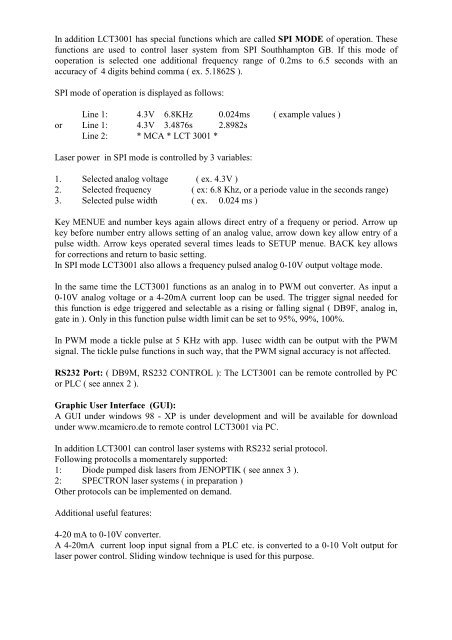Universal laser controller and testunit for SPI Laser ... - mcamicro.de
Universal laser controller and testunit for SPI Laser ... - mcamicro.de
Universal laser controller and testunit for SPI Laser ... - mcamicro.de
Create successful ePaper yourself
Turn your PDF publications into a flip-book with our unique Google optimized e-Paper software.
In addition LCT3001 has special functions which are called <strong>SPI</strong> MODE of operation. These<br />
functions are used to control <strong>laser</strong> system from <strong>SPI</strong> Southhampton GB. If this mo<strong>de</strong> of<br />
ooperation is selected one additional frequency range of 0.2ms to 6.5 seconds with an<br />
accuracy of 4 digits behind comma ( ex. 5.1862S ).<br />
<strong>SPI</strong> mo<strong>de</strong> of operation is displayed as follows:<br />
Line 1: 4.3V 6.8KHz 0.024ms ( example values )<br />
or Line 1: 4.3V 3.4876s 2.8982s<br />
Line 2: * MCA * LCT 3001 *<br />
<strong>Laser</strong> power in <strong>SPI</strong> mo<strong>de</strong> is controlled by 3 variables:<br />
1. Selected analog voltage ( ex. 4.3V )<br />
2. Selected frequency ( ex: 6.8 Khz, or a perio<strong>de</strong> value in the seconds range)<br />
3. Selected pulse width ( ex. 0.024 ms )<br />
Key MENUE <strong>and</strong> number keys again allows direct entry of a frequeny or period. Arrow up<br />
key be<strong>for</strong>e number entry allows setting of an analog value, arrow down key allow entry of a<br />
pulse width. Arrow keys operated several times leads to SETUP menue. BACK key allows<br />
<strong>for</strong> corrections <strong>and</strong> return to basic setting.<br />
In <strong>SPI</strong> mo<strong>de</strong> LCT3001 also allows a frequency pulsed analog 0-10V output voltage mo<strong>de</strong>.<br />
In the same time the LCT3001 functions as an analog in to PWM out converter. As input a<br />
0-10V analog voltage or a 4-20mA current loop can be used. The trigger signal nee<strong>de</strong>d <strong>for</strong><br />
this function is edge triggered <strong>and</strong> selectable as a rising or falling signal ( DB9F, analog in,<br />
gate in ). Only in this function pulse width limit can be set to 95%, 99%, 100%.<br />
In PWM mo<strong>de</strong> a tickle pulse at 5 KHz with app. 1usec width can be output with the PWM<br />
signal. The tickle pulse functions in such way, that the PWM signal accuracy is not affected.<br />
RS232 Port: ( DB9M, RS232 CONTROL ): The LCT3001 can be remote controlled by PC<br />
or PLC ( see annex 2 ).<br />
Graphic User Interface (GUI):<br />
A GUI un<strong>de</strong>r windows 98 - XP is un<strong>de</strong>r <strong>de</strong>velopment <strong>and</strong> will be available <strong>for</strong> download<br />
un<strong>de</strong>r www.<strong>mcamicro</strong>.<strong>de</strong> to remote control LCT3001 via PC.<br />
In addition LCT3001 can control <strong>laser</strong> systems with RS232 serial protocol.<br />
Following protocolls a momentarely supported:<br />
1: Dio<strong>de</strong> pumped disk <strong>laser</strong>s from JENOPTIK ( see annex 3 ).<br />
2: SPECTRON <strong>laser</strong> systems ( in preparation )<br />
Other protocols can be implemented on <strong>de</strong>m<strong>and</strong>.<br />
Additional useful features:<br />
4-20 mA to 0-10V converter.<br />
A 4-20mA current loop input signal from a PLC etc. is converted to a 0-10 Volt output <strong>for</strong><br />
<strong>laser</strong> power control. Sliding window technique is used <strong>for</strong> this purpose.


